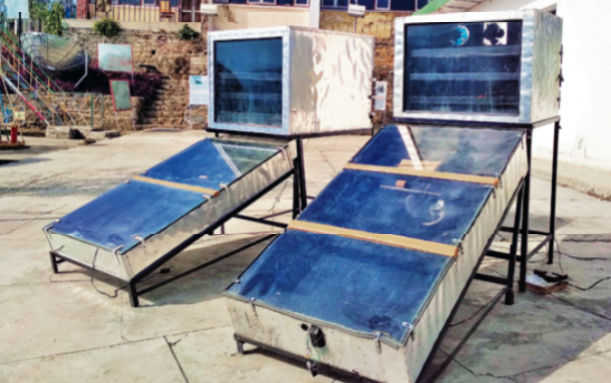Solar drying — the way forward
Ambika Sharma
A solar dryer, developed by scientists at Dr YS Parmar University of Horticulture and Forestry, Nauni, is emerging as a cost-effective device to reduce post-harvest losses and enhance the shelf life of agrarian produce.
Post-harvest losses account for 10-30 per cent of the production due to the perishable nature of the produce, inclement weather and lack of transportation facilities. Even widespread damage to the crop by wild animals incurs huge loss to the agrarian community every year.
As much as 20 per cent tomatoes, 10 per cent ginger and an equal amount of mushroom, 30 per cent emblica officinalis (amla) and 5 per cent apples are damaged or wasted every year due to post-harvest losses. Apart from this, crops such as tomatoes and pomegranate produced during the rainy season are lost due to the moist weather.
Developed under a project funded by the seed division of the Department of Science and Technology, Government of India, 11 such dryers have been installed in the fields in Himachal and Uttarakhand.
Principal investigator Dr RK Aggarwal and co-investigators Dr SK Bhardwaj and Dr Rakesh Sharma, who were instrumental in devising this low-cost technological device for drying fruits, vegetables, seeds and other crop products, are optimistic that its use would help enhance the farm income.
Traditional method hit farmers’ earning potential
Traditionally, precious man hours were required to carry products in and out of the house for completing the drying process in the open sun. Farmers used this method to dry fruits such as apple, peach, pomegranate, palm nut and vegetables such as chilli, turmeric and ginger. As a result, the dried product was of inferior quality as dust, fungus, infection, insects, sudden rain and wild animals, particularly monkeys, adversely affected their quality. This severely hit the earning potential of farmers, with most of them having no other means of livelihood.
Better than traditional method
The indirect solar dryer facilitates drying of fruits, vegetables, seeds and medicinal plants without changing their basic properties. They preserve the agrarian produce by removing adequate moisture from them and further preventing their decay and spoilage. The water content of solar-dried food varies from 5 to 25 per cent depending on the type of food thereby enhancing the shelf life of the crop. Different products can be easily dried in the indirect solar dryer under clean conditions in a reasonably short period, explained Dr Bhardwaj.
Even though the traditional method is less expensive and does not involve any technological intervention, its limitations such as contamination of the produce due to dirt and insects, attack by birds, mice and animals, damage due to erratic weather and uncontrolled temperature, poor quality of dried products, loss of nutrients due to direct exposure to ultraviolet rays and low market price vis-à-vis its labour intensiveness have left the growers high and dry.
As much as 90 per cent of the women in the hills remain engaged in the traditional drying of products and spend at least two hours daily in these activities, which costs at least Rs 60 per day as labour input. The indirect solar dryer, on the other hand, has helped farmers overcome these handicaps such as quality hygienic product, reduced drying time, protection from erratic weather, insects and pests, and wild animals and better market rates. Unlike open sun drying, the temperature, humidity and drying rate can be changed to some extent in these dryers making it the most sought-after product.
Several types of dryers are available in the country, but these are not popular in rural areas due to their high cost, lack of technical know-how or lack of skill to use these. The solar dryers of variegated types can be made locally and of different size.
Types of solar dryers
- There are two types of solar dryers — forced and natural convection solar dryer. The forced convection solar dryer is considered to be efficient, reliable and fast and can dry large quantity of crop products as compared to natural convection solar dryer.
- These dryers have been provided with fans in the inlet of the solar air heater to reduce the humidity of the air entering the solar air collector.
- Studies revealed that the temperature in the solar dryer remains above the usual temperature, thereby reducing the drying time. The thermal storage system provided at the bottom of the solar air heater and wheels at the base of the dryer enables it to move with the sun during the day, thus enhancing its efficiency from 15.09 per cent to 21.76 per cent, which is considered to be high. The quality parameters of the dried products have also been found to be better as compared to the oven-dried and open sun-dried products.
Factfile
- Advantages such as enhanced shelf life, quality standards further add to its value.
- The process also helps in reducing carbon emission, thus making it the much sought-after product for drying various crops, especially in developing countries.
- The dryer has a capacity of 40 kg and can be fabricated by local artisans.
- The dryers have been installed in different agro-climatic zones covering Chamba, Kangra, Hamirpur, Solan, Shimla, Kinnaur, Sirmaur, Mandi and Kullu in HP and Chakrata and Uttarkashi in Uttarakhand.
- The main products dried by farmers in this dryer include apple chips, barian, herbal products, vegetables, pomegranate, apricot, tomato, turmeric, red chilli etc.
- Local carpenters from the two states have been trained by scientists in the fabrication of solar dryers and to keep them operational.
- The cost of a dryer varies between Rs 35,000 and Rs 40,000 depending upon the capacity and the scientists are creating awareness to enhance its utilisation









